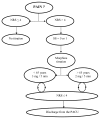Age-adapted morphine titration produces equivalent analgesia and adverse effects in younger and older patients
- PMID: 18184441
- PMCID: PMC2652637
- DOI: 10.1017/S0265021507003080
Age-adapted morphine titration produces equivalent analgesia and adverse effects in younger and older patients
Abstract
Background: To determine the efficacy and safety of intravenous postoperative morphine titration in the elderly compared with younger patients.
Methods: In the post-anaesthesia care unit, patients complaining of pain received morphine until adequate pain relief. Intravenous morphine was titrated as 3 mg boluses in young (age 65 yr) and 2 mg in elderly patients (>65 yr) every 5 min.
Results: We studied 350 young and 68 elderly patients. There were no significant differences between the two age groups for pain intensity at the onset of titration (numerical rating scale, 7.4 +/- 1.7 in young vs. 7.5 +/- 1.7 in elderly patients), area under the curve of numerical rating scale vs. morphine boluses (97.7 +/- 59.6 vs. 98.2 +/- 62), number of boluses required to obtain pain relief (3 +/- 1.3 vs. 3 +/- 1.3), percentage of titration failures (10% vs. 9%) and incidence of excessive sedation (18% vs. 21%). Renal clearance was significantly reduced in elderly compared with young patients (55 +/- 21 vs. 85 +/- 15 mL min(-1); P < 0.0001).
Conclusion: Using lower bolus doses, pain relief in the immediate postoperative period with morphine was as efficacious and safe in elderly patients as in younger patients. The decrease in renal clearance of morphine in the elderly justifies the reduction of intravenous morphine boluses for the treatment of postoperative pain.
Figures

Similar articles
-
Effects of intravenous patient-controlled analgesia with buprenorphine and morphine alone and in combination during the first 12 postoperative hours: a randomized, double-blind, four-arm trial in adults undergoing abdominal surgery.Clin Ther. 2009 Mar;31(3):527-41. doi: 10.1016/j.clinthera.2009.03.018. Clin Ther. 2009. PMID: 19393843 Clinical Trial.
-
Opioids and the management of chronic severe pain in the elderly: consensus statement of an International Expert Panel with focus on the six clinically most often used World Health Organization Step III opioids (buprenorphine, fentanyl, hydromorphone, methadone, morphine, oxycodone).Pain Pract. 2008 Jul-Aug;8(4):287-313. doi: 10.1111/j.1533-2500.2008.00204.x. Epub 2008 May 23. Pain Pract. 2008. PMID: 18503626
-
A high initial VAS score and sedation after iv morphine titration are associated with the need for rescue analgesia.Can J Anaesth. 2004 Dec;51(10):969-74. doi: 10.1007/BF03018481. Can J Anaesth. 2004. PMID: 15574544
-
Opioid-induced sedation in the postanesthesia care unit does not insure adequate pain relief: a case-control study.Anesth Analg. 2007 Oct;105(4):1143-7, table of contents. doi: 10.1213/01.ane.0000281441.93304.e3. Anesth Analg. 2007. PMID: 17898402
-
[Intravenous morphine titration].Ann Fr Anesth Reanim. 2004 Oct;23(10):973-85. doi: 10.1016/j.annfar.2004.08.010. Ann Fr Anesth Reanim. 2004. PMID: 15501627 Review. French.
Cited by
-
[Pain therapy in emergency medicine. Focus on emergency admissions].Anaesthesist. 2013 Nov;62(11):902-8, 910-3. doi: 10.1007/s00101-013-2247-x. Anaesthesist. 2013. PMID: 24173544 Review. German.
-
Subjective risk factors of severe pain at discharge from the emergency department.Intern Emerg Med. 2025 Apr;20(3):899-907. doi: 10.1007/s11739-024-03730-4. Epub 2024 Aug 6. Intern Emerg Med. 2025. PMID: 39107668 Clinical Trial.
-
Postoperative analgesia in elderly patients.Drugs Aging. 2013 Feb;30(2):81-90. doi: 10.1007/s40266-012-0047-7. Drugs Aging. 2013. PMID: 23288604 Review.
-
[Opioids for noncancer pain in the elderly].Schmerz. 2015 Aug;29(4):380-401. doi: 10.1007/s00482-015-0029-x. Schmerz. 2015. PMID: 26264898 German.
-
Intravenous lornoxicam is more effective than paracetamol as a supplemental analgesic after lower abdominal surgery: a randomized controlled trial.World J Surg. 2012 Sep;36(9):2039-44. doi: 10.1007/s00268-012-1649-2. World J Surg. 2012. PMID: 22584689 Clinical Trial.
References
-
- Clergue F, Auroy Y, Péquignot F, Jougla E, Lienhart A, Laxemarie MC. French survey of anaesthesia in 1996. Anesthesiology. 1999;91:1509–20. - PubMed
-
- Rooke GA, Reves JG, Rosow C. Anesthesiology and geriatric medicine (editorial) Anesthesiology. 2002;96:2–4. - PubMed
-
- Organizations JCoAoH. Pain: Current understanding of assessment, management, and treatments. December 2001. 2005. Available at: www.jcaho.org.
-
- Ferrell BR, Shaffner M. Pharmacoeconomics and medical outcomes in pain management. Semin Anesth. 1997;16:152–9.
-
- Karani R, Meier DE. Systemic pharmacologic postoperative pain management in the geriatric orthopaedic patient. Clin Orthop Relat Res. 2004;425:26–34. - PubMed
Publication types
MeSH terms
Substances
LinkOut - more resources
Full Text Sources
Miscellaneous

